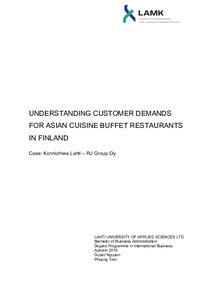UNDERSTANDING CUSTOMER DEMANDS FOR ASIAN CUISINE BUFFET RESTAURANTS IN FINLAND
Tran, Phuong; Nguyen, Duyen (2019)
Tran, Phuong
Nguyen, Duyen
2019
All rights reserved. This publication is copyrighted. You may download, display and print it for Your own personal use. Commercial use is prohibited.
Julkaisun pysyvä osoite on
https://urn.fi/URN:NBN:fi:amk-2019121526820
https://urn.fi/URN:NBN:fi:amk-2019121526820
Tiivistelmä
The migration of numerous of foreigners in Finland has brought cuisines from countries
around the world to Finland. Against the context, sushi has been introduced to Finland
and immediately became popular. The rising of Asian cuisine and sushi restaurants is
recognized due to the increase in customer demands. That created the authors’ interest
and curiosity.
The study findings are expected to not only provide information for the case company to
improve its customer service strategies but also to contribute insights into parties that
concerns about the food industry in Finland.
The study applies the consolidation of quantitative and qualitative methods. The quantitative technique is executed by using a web-based and hard copy questionnaire. The
qualitative method is carried out with face-to-face interviews with customers in Konnichiwa restaurant in cooperation with the open-ended questions in the survey. The interviews occurred in one day with three respondents and the survey process transpired
in two weeks at Konnichiwa restaurant obtained two hundred and ten valid responses.
By applying a statistical analysis, an explicit segment of Konnichiwa customer is defined. The most common age range of customers that come to Konnichiwa is from 18-
40 years old accounting for 66% and their average income is 2,500 euros and above.
When considering choosing buffet restaurant most criteria that are chosen are price,
customer service, and location. Most of the customers were satisfied with Konnichiwa
customer service yet there is still room for improvement; for instance, adding more vegetarian food, gluten-free options, and lactose-free dessert would target more customers.
The study results are respectable and beneficial for developing customer service strategies, marketing campaigns for each target customer group. Also, reducing food waste
to cut down costs is possible with the collaboration with ResQ Club.
around the world to Finland. Against the context, sushi has been introduced to Finland
and immediately became popular. The rising of Asian cuisine and sushi restaurants is
recognized due to the increase in customer demands. That created the authors’ interest
and curiosity.
The study findings are expected to not only provide information for the case company to
improve its customer service strategies but also to contribute insights into parties that
concerns about the food industry in Finland.
The study applies the consolidation of quantitative and qualitative methods. The quantitative technique is executed by using a web-based and hard copy questionnaire. The
qualitative method is carried out with face-to-face interviews with customers in Konnichiwa restaurant in cooperation with the open-ended questions in the survey. The interviews occurred in one day with three respondents and the survey process transpired
in two weeks at Konnichiwa restaurant obtained two hundred and ten valid responses.
By applying a statistical analysis, an explicit segment of Konnichiwa customer is defined. The most common age range of customers that come to Konnichiwa is from 18-
40 years old accounting for 66% and their average income is 2,500 euros and above.
When considering choosing buffet restaurant most criteria that are chosen are price,
customer service, and location. Most of the customers were satisfied with Konnichiwa
customer service yet there is still room for improvement; for instance, adding more vegetarian food, gluten-free options, and lactose-free dessert would target more customers.
The study results are respectable and beneficial for developing customer service strategies, marketing campaigns for each target customer group. Also, reducing food waste
to cut down costs is possible with the collaboration with ResQ Club.
